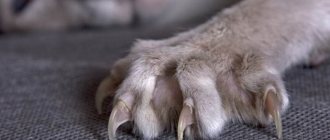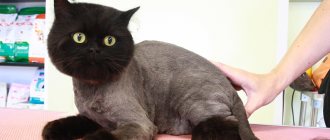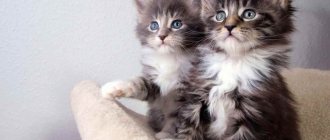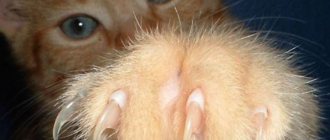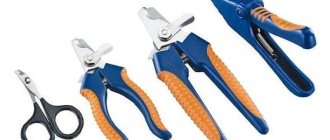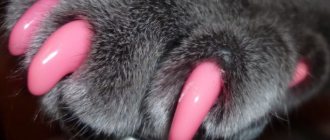Every member of the cat family has claws. They serve as protection from the dangers of the outside world. But pets do not need to regularly defend themselves, keeping enemies away. But sharp blades on the paws can cause a lot of problems for owners. Damaged furniture, wallpaper and other coverings look ugly. And when even special scratching posts do not improve the situation, owners decide to use scissors to fix the problem. It’s worth figuring out whether it’s possible to trim a cat’s claws and what to consider to make the process easier.
Why does a kitten need nails?
It’s clear why cats living outside need claws. And to escape from danger, and to feed. Why does a pet need them? He doesn't leave the apartment. And he has no idea what hunting is. Maybe you shouldn’t bother with the question of at what age can a kitten’s nails be trimmed? How about taking the baby to the veterinary clinic and getting rid of this sharp weapon?
So we get to the main idea. Claws are a cat's weapon. They are also compared to human fingers. It is the claws that help animals sense balance and play an important role in the pet’s spatial orientation. It has long been known that cats that are deprived of this important addition to their paws become “crippled.” Their musculoskeletal system is impaired.
Why do you need to cut your hair?
A cat's claws grow daily; animals visiting the street wear down the tips of their nails, climbing trees, walking on the asphalt. A pet does not have this opportunity, and daily sharpening on a scratching post makes them especially sharp.
Too long claws bother the cat; the pet tries to chew off the ends on its own and sharpens its nails on hard surfaces.
Don't forget about the fifth nail; its location on the front paws is such that at home the nail is constantly growing, and playing with a scratching post will not help here. Over time, too long a nail digs into the pad of the front paw, causing the animal discomfort when moving, affecting the animal's activity.
The process of growth of nail plates is individual, one cat needs to be trimmed once every thirty days, another every two weeks.
The circumcision procedure can be performed at a veterinary clinic or you can do a “cat manicure” yourself.
To cut your hair at home, you need to get professional equipment.
On a note! It is unacceptable to cut nail plates using manicure or kitchen scissors; such tools can injure the animal, damage blood vessels on the fingers, and introduce infection into the body.
The owner should buy a trimmer (nail clipper) at a pet store; the device is a guillotine-type scissors; with the help of a nail clipper, it will be possible to remove the excess length without harming the health of the pet.
When can you start cutting your newborn's nails for the first time?
One of the first questions that a young mother has when caring for her baby is how long after birth can she cut her newborn’s nails?
?
As soon as the baby is born, the edges of his nail plates do not separate from the skin, as they are quite soft. This is why you should not cut a newborn’s nails in the first two weeks - to avoid skin damage and, as a result, a possible inflammatory process. To prevent the child from scratching himself during this period, it is recommended to wear special mittens.
A month after birth, you can safely start cutting your baby’s nails.
Removal
At what age can a kitten's nails be trimmed? How should an adult cat cut them? Do you need to go to the clinic every time? At home, on your own? No, your hand won't rise. We'll have to carry it. And this will take time. Remove these claws once and for all. Moreover, why does the cat need them? Should I sit at home with my claws? Only the sofa spoils the wallpaper, he ignores the scratching post, he’s a bad creature. This is a bunch of questions swirling around in the owners’ heads.
The owner loves his animal and wants to do the best for everyone. It would be nice to rid the kitten of its claws, as it doesn’t seem to need them at all. And yourself - from problems with damage from these very claws. Just before taking your pet for surgery to remove them, you need to think several times. Is it worth it?
As mentioned above, in animals without claws the functioning of the musculoskeletal system is impaired. And that is not all. A cat, deprived of its main support and tool for protection, experiences extreme stress. Once outside, such an animal will die immediately. He has no chance of salvation.
Here the emphasis has been long and persistently placed on the musculoskeletal system. Someone will be surprised what claws have to do with it. The thing is that during the declawing operation, the phalanges of the cat’s fingers are cut off. Imagine that a person has been partially deprived of his toes. How will he walk after this? And now it becomes clear what it’s like for the cat.
Consequences of the operation
Animal rights activists are unequivocally against such a procedure if it has no medical indications. They compare cat declawing surgery to removing the last phalanx of a human finger. In turn, doctors argue that this is an inappropriate comparison. However, after a total onychectomy, the cat experiences irreversible changes.
Here are the consequences you can notice in a cat after declawing:
- inflammation of soft tissues and even osteomyelitis (necrotic process);
- During the operation, the cat may lose a large amount of blood;
- the healing process, as a rule, turns out to be longer than predicted;
- the animal’s coordination of movements is impaired;
- the character of the cat changes, since the rehabilitation process takes a long time and is very painful;
- you need constant control over the animal so that it does not damage the stitches;
- the cat may not cope well with anesthesia;
- the pet begins to ignore the tray, because it will not be able to rummage through it as before.
These are just some of the unpleasant consequences of declawing. Of course, if there are medical indications for removal, then they should not be ignored. But it is also worth understanding that for medical reasons, a cat is not deprived of all its claws, but only sick or damaged ones are removed.
Why does a cat need claws?
When the cat was wild, they were needed so as not to remain hungry and not become the prey of a stronger animal. Then why do cats have claws now? There is no need to hunt - the food is always in the bowl, and those living at home have no purring enemies.
Progressive owners decide to take radical measures and declaw the cat. This is strictly forbidden. In almost all European countries, this operation, called onychectomy, is prohibited because it causes irreparable harm to health.
An improperly performed surgical operation can lead to:
- to gait disturbance;
- constant pain in the paws;
- development of infectious diseases.
The operation involves removing the claw and cutting off the phalanx of the finger. The healing process is very difficult and painful. Getting up on her paws is painful and she will limp or not be able to walk at all. The cat will lick the sore spots and will have to wear a special collar. An additional health risk is general anesthesia.
Typically, animals after onychectomy become irritable and capable of showing aggression. Unable to defend themselves otherwise, they may bite. The cat will not be able to jump even to the minimum height.
Tendonectomy is no less traumatic - cutting the flexor tendon, which ensures the release of the claws. A part of it is cut off, and the cat will always keep its claws retracted and will not be able to scratch or cling to anything.
The discomfort and pain that the pet experiences are a small part of the negative consequences. The joint cannot move normally, and the tendon takes a long time to heal. The cat suffers physically and is harmed to its mental health. There is a danger of infections and other complications.
Subsequently, you will still have to trim the overgrown claws, since the cat will not be able to do this on its own. So isn’t it better to do this regularly, without causing unnecessary pain to your beloved pet?
Reviews
Reviews from owners about declawing cats, as well as opinions about the advisability of the procedure, vary greatly. Below are several reviews from owners who decided to undergo this complex operation.
Victoria, Barsik's owner:
“Our Barsik has always been a calm and beloved cat. But at some point he began to show unjustified aggression towards his husband and some other household members. We were never able to establish the cause; cat sedatives did not help. Having lost a long battle, we made a desperate decision - to deprive Barsik of his claws. The operation was successful, rehabilitation took a little over a month. The cat changed completely, became calm, even somewhat unsociable. Activity has decreased greatly. I can’t say that I regret the operation, since our problem was completely resolved.”
Marina, owner of Sonya and Kitty:
“Sonya has always been a calm cat. A few years later we decided to make her a girlfriend. That's how we got a Kitty. The girls quickly became friends, but sometimes they still fought. One day, Sonya scratched the youngest one very badly; she even had to resort to the help of a veterinarian. That's when we decided to remove Sonya's claws.
The operation went well, but the rehabilitation period was extremely difficult. The cat was lethargic, her appetite was weak, there was not a hint of affection left. Over time, Sonya began to boldly walk on her paws, but a slight limp remained. Her jumps were timid, and she could not balance on high shelves. Sonya began to completely ignore the tray. Of course, we have solved the issue of cat fights once and for all, but we have completely lost our favorite. I really regret taking this step.”
Nail trimming and breed
At what age can you cut the nails of a Scottish, Siamese or Persian kitten? In fact, nothing depends on the breed here. It all depends on the age of the animal. Claws are formed in felines by the age of 4-6 months. It is during this period of time that owners begin to prune them.
Do I need to take my pet to the veterinary clinic for this? If the owner is very afraid to perform the procedure on his own, then it is possible. But there is nothing complicated about this manipulation. Below we will tell you in detail how to trim your pet's claws.
Trimming nails at home or at a professional?
Many owners are afraid to cut their pet's nails, and there are reasonable reasons for this. Being in a familiar environment (at home) and resisting a person they know well (the owner), cats do indescribable things: they bite, scratch, scream and escape from their hands. It is for this reason that experienced owners recommend not to take risks using ordinary scissors or trying to carry out the procedure alone.
During a similar procedure in a veterinary clinic or grooming salon, the same pet behaves calmly. Why is this happening? The fact is that the cat is confident that it can manipulate the owner, and when in a stressful environment it behaves instinctively - it hides and waits. By the way, any veterinarian and groomer will teach you how to cut nails at the correct angle and determine the location of the cut.
Trimming nails for the first time - nuances
How to properly trim a kitten's claws for the first time so that he is not afraid of the procedure in the future? You only have two options:
- Contacting a veterinarian or groomer - the disadvantage of this method is that transportation in a carrier and carrying out the procedure in an unfamiliar room is serious stress. On the other hand, even if something goes wrong, the pet will not associate negative emotions with the owner.
- Trimming nails at home means there is a high risk of injuring and frightening your pet.
Since both options are not universal, new owners are advised to consider a third alternative - calling a specialist to your home. Yes, in this case, the procedure will cost you a little more, but you will be sure that the cat will not become stressed due to a sudden change in environment.
How to calm a cat if he doesn't give in?
Do you firmly intend to cut your pet’s nails yourself, you know how to do it and have already bought a nail clipper, but you don’t know how to carry out the procedure on your pet if it doesn’t work?
Here are some methods that may help you:
- Place your cat in an unfamiliar environment, such as trying to trim its nails in a stairwell. Naturally, this method cannot be practiced alone because the pet may escape.
- Tire your pet out before grooming with active play.
- Use veterinary sedatives or calming herbs.
Of course, the best remedy is to purchase a special bag for caring for cats - the bag is sewn in such a way that it restricts the movement of all paws. By unfastening the corners one at a time, you can free one paw at a time and trim the claws. The accessory is designed for bathing cats, trimming claws, brushing teeth and performing other procedures in which the pet violently resists.
How to trim claws correctly?
It is important to learn how to trim your furry pet's nails correctly. Inept actions can lead to serious injury and severe stress for the animal. If there are significant doubts about the correctness of your actions or fear of manipulation, it is recommended to entrust the first haircut to a professional, so that, after observing the process, you can subsequently repeat it at home without any fears.
Haircut procedure
How to trim your little friend's nails? This is the most important question owners ask. And no wonder, a person is afraid of hurting his animal. Particularly fearful people go to a veterinary clinic and entrust the procedure to specialists. And for those who decide to cut their nails on their own, detailed instructions are provided on how to do this.
At what age can a British kitten's nails be trimmed? As mentioned above, breed does not matter. Only sphinxes begin to cut their claws earlier than others because of their skin characteristics.
But let's move on to the most basic thing - the haircut procedure. What you need to know about it:
- The necessary tool is special nail clippers for cats. Sold in pet stores. Or you can get by with simple nail scissors, nippers or tweezers. Nail scissors have been tested by the personal experience of many owners.
- Before starting the procedure, the instrument must be disinfected. Wipe with alcohol, for example.
- Pick up the kitten. Sit with him on a chair or in an armchair near the window. To see the blood vessel in the nail without damaging it, you need good lighting.
- We sit the kitten facing us.
- Nail trimming begins with the front paws. The paw is taken between the fingers and lightly pressed on it so that the animal releases its claws. The claw is lifted with a tool and only the light base is cut off without affecting the blood vessel.
- After the claws on the front paws are trimmed, we proceed to the hind paws.
- At the end of the procedure, you can praise the kitten and give something tasty.
As you can see, the procedure for trimming nails is not as complicated and scary as it seems at first. By the way, let us remind you at what age you can cut a kitten’s claws. From 4-6 months.
What to do if your cat resists
Cutting a small kitten's nails is not recommended.
They are not strong enough to cause harm. The main danger is the procedure for the animal itself. Thin claws do not allow you to see the beginning of the sensitive area. It is easy to injure a kitten and cause an infection.
Important! Veterinarians advise starting to trim nails at 2.5 months. You can wait until 3 or 4. This makes it easier to accustom the animal to the procedure. Once you start trimming the claws of an adult animal, you will encounter resistance. The cat will bite, kick, and become hysterical. A kitten accustomed to the procedure will behave calmly even as it matures.
Another advantage of starting the procedure at an early age: you will learn how to easily squeeze out claws. Cats hide them: they pull them in and release them as needed.
If you decide to undergo the procedure at home, be patient and have the necessary tools.
Consider:
- Claw clipper. Your nail clippers will not work, nor will your garden pruners. The instrument will have to be purchased at a veterinary pharmacy.
- Potassium permanganate solution or hydrogen peroxide. We don’t want to introduce an infection to our beloved kitty.
- Cotton wool.
- Nail file.
| № | Actions | Explanations |
| 1 | Prepare all tools in advance, sterilize them: wipe with alcohol or dip in boiling water | The cat will not give you a chance to go get the missing supplies. He is unlikely to be delighted with your idea |
| 2 | Calm the animal | Pet the cat. It is better if he is full and satisfied |
| 3 | Hold the tool perpendicular to the nail | A different position will cause separation of the keratinized part |
| 4 | We press on the paw and see how the claw comes out under pressure. Cut no more than 2mm from the tip | This is enough for the animal to lose the ability to tear wallpaper, chair covers and curtains |
| 5 | We cut each paw separately, file it, treat it with peroxide or wipe it with a solution | No need to file |
This is what the ideal procedure looks like: calmed, squeezed, trimmed, filed and processed. There is little chance that the cat will look indifferently at the TV during the manipulation.
If the animal actively resists, the procedure should be interrupted. Do not put your cat into a stressful situation.
Important! If you manage to cope, remember: you should trim the claws only from the front paws. Don’t be alarmed if, when counting, you find only 18 nails: there are exactly that many of them in cats. 4 on each hind paw, and 5 on the front paws.
If your cat won’t let you cut her nails, you can try to accustom her to this procedure gradually, the main thing is to be patient.
Try a few simple tricks:
- If your cat doesn’t have enough patience for a long time, start small. To begin with: cut two claws and release the pet, not forgetting to praise. Then cut off more, and increase the number of toes until you have processed all the paws.
- Wait until the cat has no desire to resist when she has eaten and becomes sleepy.
- Try trimming nails while your cat is sleeping.
- If your cat becomes stressed due to the procedure, you can try giving him sedatives using natural herbs, for example, “Cat Bayun”.
- If you catch a kitten in a playful mood, you should postpone claw trimming until the kitten becomes less agitated.
We hope that our article will help you develop an effective strategy for trimming your pet's nails. If your cat won’t let you get close to his manicure with scissors or has an aggressive character, then we recommend reading our article about silicone anti-scratch pads (harmless to the pet’s body and a solution for responsible owners). Share with us and our readers in the comments: what tricks do you practice when trimming your cats’ claws?
Of course, the most important thing you can give your cat is attention, love and care. However, in addition to this, caring for your pet also falls on your shoulders. Therefore, it is important for all furry owners to know how to trim a kitten’s claws. This will help avoid incorrect actions and make the procedure much easier, faster and safer for the animal.
Many people today wonder whether it is necessary to trim a cat’s claws? I cannot give you a unanimous answer to this question. Of course, if your pets behave quite neatly and do not damage the furniture, then the process of trimming their claws is not so necessary. In addition, there are special devices for purrs called “scratching posts.” They allow you to get rid of old claws much faster.
However, I have to admit to you that not all furry people actually recognize such products. They can climb on scratching posts, lie near them, or even play with them. However, as soon as you turn away, the animal will go to sharpen its claws towards your favorite sofa.
In nature, everything is much simpler and more thoughtful. Outdoor cats climb trees, thereby getting rid of old claws. At home, your favorite interior items can be used for the same purpose. In addition, in the process of falling off, the claws often begin to separate or bend, growing under the skin. In this case, the animal may feel severe pain.
Why is nail trimming the ideal solution? Compared to some surgical operations (onychectomy), which are offered by many modern veterinarians, trimming a cat’s nails with scissors at home does not harm the physical and mental health of the furry cat.
Do you want to figure out how to trim a cat's claws at home? First of all, please note that this procedure must be treated as carefully as possible. Be sure to make sure there is bright lighting in the room.
We suggest you read: How to stop a toy terrier from barking
It is also important to prepare all the necessary tools for trimming claws. They can be quite different (in the form of scissors, forceps, guillotine nail clipper). Each kitten is unique - some may have thin, brittle claws, while others may have large and sharp ones. Therefore, I recommend that you stock up on all the options and, during the procedure, experimentally find out which type of scissors is convenient for you and your pet.
Cat nail clipper
To trim your cat's claws, you will need:
- Nail clipper (sold at any veterinary store). It is this tool (and not ordinary nail scissors) that veterinarians recommend. The design of scissors for trimming cat claws allows you to quickly and conveniently give even the smallest pet a manicure.
- Trimmer for cutting hair around claws. Sometimes, in order to trim cats' nails as quickly and safely as possible, you should cut off a little hair on the paw.
- Cotton wool.
- Antiseptics for disinfection and stopping bleeding (in case of a wound). The best option is hydrogen peroxide.
- File that prevents delamination.
By the way, many veterinary stores sell a so-called “manicure set” for cats. It contains all the necessary tools and is specially designed for trimming cats' nails.
Benefits of claw trimming
The question of whether a cat’s claws need to be trimmed is a top priority for owners, and many decide positively. Compared to removal, this method is still much more humane, and the cost of declawing a cat is quite high. Firstly, pets cannot grind their claws down to the desired size on their own; they grow too long and can peel off, become ingrown and injure their paw pads. In addition, cats have a so-called fifth claw located on the back of their front paws. This nail always grows freely, without participating in the cat’s scratching, and therefore she does not have the opportunity to sharpen it.
If you do not take care of the animal's claws and do not trim them if necessary, the fifth claw can begin to grow in and cut quite painfully into the pads of the paws.
There is no need to cut it too often; it is enough to do it during the main procedure.
Secondly, we cannot ignore the everyday side of the issue. Almost all owners of domestic cats have had to live in an apartment with peeled wallpaper and sofa upholstery, scratched furniture and flooring.
Thirdly, the question of whether it is possible to cut the nails of cats is always answered in the affirmative by owners of purebred animals - such a haircut is a necessary procedure before exhibitions. Pedigree kittens often have their claws trimmed in the first week after birth.
Finally, this procedure is simply necessary if there are children in the house - whether cats can have their claws trimmed varies from owner to owner, but the child must be completely protected from possible injuries. Or, instead of cutting the claws, you can try putting special caps on the cat.
When should you trim your cat's nails?
Animals that roam freely outside do not need pruning. Claws are a cat's tool. Until now, free-ranging cats use them to help them climb trees and other surfaces, serve as a means of protection, a tool for holding prey, and prevent slipping when moving on slippery surfaces. Trimming a street cat's claws means seriously complicating his life. He grinds them down himself.
Another thing is completely domestic pets. If the owner has not trained him to use a scratching post, then the procedure for trimming cats’ claws is carried out in order to preserve not only furniture, floor coverings, but also the health of the pets. But even with a scratching post, the claws are not worn down enough.
At what age can you start?
If the breeder has never trimmed the puppy’s nails, then try to accustom the baby to cutting his nails literally from the first days of his stay in your home.
If you have acquired a 2-month-old baby, then it is quite possible to accustom him to this procedure . After all, the sooner you start, the easier it will be for you in the future, since the pet will not be afraid and nervous.
Expert opinion
Kozhevin Semyon Kirillovich
Expert dog handler.
“Experienced breeders try to start trimming puppies’ nails as early as possible, from about 1.5 to 2 weeks of age. This is necessary so that the baby does not scratch the mother’s mammary glands and she does not refuse to feed. Sometimes, such a haircut is a matter of survival of the whole litter. And since puppies’ nails grow quickly, they are trimmed at least once every 2 weeks. For an adult dachshund, one haircut per month will be enough.”
Individual approach to haircut frequency
Trimming should be done as needed, as soon as the nails are back to their previous size. Many factors influence the growth rate, including the individual characteristics of the pet. Some only need a haircut once a month, while others need it every two weeks. It depends on the breed of the cat and its genetics.
Monthly
If the claws grow slowly, it is enough to trim them once a month. Before the procedure, you should definitely examine the condition of your nails. For many breeds, monthly care is enough and there is no need to increase the number of procedures every few weeks.
Once every one and a half to two weeks
In Persian cats and Sphynxes, marigolds are characterized by a rapid growth rate and strong stratification. For this reason, they should be treated every two weeks.
If your pet's claws are black, it is difficult to see the border between the blood vessels and the dead area. Therefore, they should be trimmed minimally. It is better to carry out the procedure every 1.5 weeks, cutting off a small amount of the nail, rather than injuring your pet’s paw.
Sometimes pets cause a lot of trouble to their owners. Those with sharp claws tend to sharpen them on furniture, walls and other objects. Regular nail trimming can solve the problem. When carrying out the procedure independently, the owner must act as carefully as possible, use only special, clean tools and take into account the cat’s mood. Otherwise, the pet will get angry and use its claws.
Our fluffy and gentle pets have natural reliable protection. These are strong, sharp little claws. They can cause serious injuries to cats, which causes concern for many owners, especially if there are small children in the house. Special microorganisms (Bartonella bacteria) nest on the claws of cats, which, when released into the bloodstream when the skin is damaged, can provoke a disease - felinosis, cat scratch syndrome, benign lymphoreticulosis, cat scratch fever, Mollaret granuloma. Under all these complex and long names lies a very unpleasant infectious disease with inflammation of the lymph nodes, fever and severe intoxication. The disease requires the use of antibiotics for treatment.
Considering the possible health risks, as well as the passionate love of cats for scratching new expensive furniture, fresh wallpaper and expensive carpets, many owners come to the conclusion that something needs to be done about their pet’s claws. In the best case, special “claw clippers” are purchased for pets; in the worst case, they decide to cut their claws or completely remove their claws, which is even worse. Before you make potentially dangerous and cruel decisions, you need to understand why cats need claws and what role they play in their lives.
How to trim a kitten's claws - nail clippers and improvised tools?
Let's say you have an urgent need to give your pet a manicure. How to trim nails yourself without harming your pet? If you have a nail clipper, the task becomes easier. If the kitten is about to have its nails trimmed for the first time, and you don’t have the tools, you can use improvised media while observing safety precautions.
Important! Don't set yourself the task of trimming all of your kitten's nails at once. If you were able to cut one claw in one approach, this is already a success.
Regular scissors
The first thing that comes to the mind of an inexperienced owner is to trim the pet’s claws with ordinary scissors, but is this possible? Hypothetically, you can...if:
- The cat will not twitch.
- You have a steady hand.
- The cat has thin claws.
- You only need to trim the ends.
What could go wrong? The structure of a cat's claws is significantly different from that of a human. When using regular scissors to trim nails, there is a very high probability of:
- Crushing a claw is very painful.
- Injuring your finger if the cat pulls its paw is even more painful.
Have you injured your pet unknowingly? In such a situation, it is extremely important to quickly stop the bleeding and ensure that the wound does not become infected. The injured claw will grow back, after which it needs to be trimmed. If the wound looks serious or your finger is injured, it is best to consult a doctor. If you don’t have nail clippers at hand, and your claws urgently need to be shortened, it’s wiser to use a nail file or nail scissors.
Nail scissors
A small kitten (1-3 months old) can have its nails trimmed with nail scissors. The only nuance is the model of the scissors. Nail scissors can be distinguished by their tips:
- Curved - for cuticles.
- Direct.
- Rounded – safe for cutting off hangnails and corners of nails.
Nail scissors with rounded tips are suitable if the nails need to be blunted rather than trimmed. Simply put, if you only need to cut off the ends so that the baby does not cling to the bedding and injure himself, you can hold off on buying nail clippers.
Can nail clippers be used to trim nails?
Nail clippers (for humans) are one of the most common tools used by inexperienced owners to injure cats. To painlessly shorten your pet's claw, you need to cut it at an angle. The blades of the tweezers close straight, but in order to set them at the desired angle, the cat's paw will have to be bent at an unnatural angle.
Again, if your pet has an exceptionally calm temperament and lies motionless in any position during the procedure, tweezers are suitable. If the pet jerks its paw when the claw is caught between the blades, it will be injured. By the way, if you use tweezers, even veterinary ones, the pressure on the handles should be firm and sharp. By cutting the claw slowly and smoothly, you risk crushing it.
How to use a guillotine correctly
Have you bought nail clippers and don’t know how to use them? The good news is that the guillotine is easy to use and the procedure is safe. The second news is that you probably won’t be able to trim all the claws the first time.
First, check your pet's reaction by touching the guillotine to the claw. Click the claw clipper and watch the reaction again. If the cat does not pull back its paw, you can try cutting it. Be sure to hold your pet's paw with your free hand. Cut off only the tip (sharper) of the claw. Your movements should be confident and firm. The guillotine cuts the claw at an angle, so the pet should not experience any discomfort.
How to prepare your cat for the procedure
The optimal time to start teaching nail trimming is 1.5 or 2 months. At an earlier age, the horny plates should not be trimmed, as they are still very fragile and easy to crumble.
From a young age, kittens are reinforced in their minds that it is not dangerous or painful. From now on, pedicures will be taken for granted.
Several rehearsals may be necessary immediately before cutting. Take the kitten by the paw so that it releases its claws and observe. Behavior should be calm. If a kitten breaks out, you need to calm it down, talk to it, and pet it. Give a treat after the massage. The purpose of such actions is to get the cat used to the fact that the owner holds his paws and releases his claws.
Some breeders recommend first introducing the cat to the tool that will be used for trimming. So that the animal gets used to the sight of the nail clipper and the sounds it makes. Uncooked spaghetti is very reminiscent of the sound of claws being trimmed. You may come across advice - cut dry pasta with scissors in the presence of your pet.
To make trimming painless, it is better to choose a time when the pet has had enough of playing, has eaten, is already a little tired and is ready to sleep.
Before trimming a kitten’s claws, you need to pet it and talk to it. An “operation” is performed on a calm animal. If the pet is nervous or is distracted by something, including birds outside the window or other pets, it is better to postpone the procedure, otherwise the cat will struggle and cause injury itself.
If the owner is calm and confident, then the cat also behaves peacefully and does not break out.
It is better to take very nervous animals or those with problems with ingrown plates to a groomer or veterinarian.
When should a kitten's nails be trimmed?
The first time the claws are trimmed is when the kitten is one month old. It is advisable that at this time he is tired and sleepy.
During the procedure, you should not play with it: it will only interfere. You should not frighten the animal, use force, or beat it. This will cause psychological trauma to the pet. In the future, the cat will be afraid of trimming.
For kittens, use guillotine cutters. The procedure must be carried out with caution, cutting off only the very tip.
What is required for a haircut at home?
A set of necessary tools:
- Hemostatic agent. This could be flour, baby powder, or hydrogen peroxide in case you hit a live part of the nail and your dog bleeds.
- A nail file is needed to remove irregularities, sharp corners and nicks after cutting.
- It is better to purchase a special nail clipper at a pet store or grooming salon.
- Cotton pads.
- Pet treat. Be sure to reward him if he behaved well during the procedure.
IMPORTANT!
Under no circumstances cut your dog’s nails with regular scissors, otherwise you will not only injure him, but also scare him.
Then cutting will become a real problem.
Cutting the tip of the claw correctly
The cat must be accustomed from childhood to your touch, then this procedure will be familiar to it and will not cause dissatisfaction. Inspecting paws after a walk outside should be mandatory. Cuts and splinters require immediate treatment.
READ Kitten vaccinations: what and when to do, vaccination table
At the pet store we select a tool for trimming claws. These can be thick nippers with a limiter, scissors with round cutouts where the claw is placed, or guillotine pliers, named after the method of cutting the claw. They have a drawback - the person cutting the tip of the claw has difficulty seeing the length to which it needs to be cut.
What to do when the animal is not given?
Pets have different temperaments. There are aggressive and nervous cats. They are unlikely to allow their nails to be trimmed in peace. Most likely, the animal will scratch, bite, and break out.
If the cat does not give in, you cannot show force: this can injure its paws. It is advisable to perform the procedure by two people: one holds, the other trims the claws. You can also swaddle your pet or wrap it in a blanket.
If he is very nervous, it is better to refuse the event and do it when the animal is more pliable and balanced.
How often should the procedure be performed?
The frequency of nail trimming depends on the conditions in which the dog lives. If your pet lives in the city and walks along the asphalt sidewalk every day, then you will trim its nails less often.
If you live outside the city, you will have to do this more often..
After all, when walking on a soft earthen surface, the claws do not wear down and can grow to serious sizes, and this is fraught with consequences.
Generally speaking, an adult dachshund's nails should be trimmed once every 3-4 weeks..
How can you tell when it's time for a haircut? By the characteristic sound of claws on the floor. As soon as you hear a clattering noise, you know it’s time to trim your nails.
Rehabilitation
As with any surgery, your furry pet will need special care after declawing to get your cat back on her paws.
For normal rehabilitation of an animal you need:
- use painkilling injections only on the recommendation of a veterinarian;
- show the operated animal to the doctor every 3-4 days;
- the stitches need to be treated daily and the dressing changed;
- It is important to ensure that the cat does not remove the protective collar. You need to protect your pet from gnawing bandages and stitches.
On average, the recovery period takes 3-4 weeks. It is not recommended to remove claws for kittens under 7 months, but in fact, it is better to first sterilize the animal and analyze its behavior. Indeed, often, the decision to remove claws is not so necessary.
When is the best time to cut a baby's nails?
For a newborn, such a process is new and unusual. In order to leave only good impressions about this in the subconscious, it is important to cut nails only when the child is in a calm state
.
The best time to do this:
- after satisfying the child’s physiological needs: feeding and changing diapers, when the baby is not suffering from colic, nothing bothers him, he is in a good mood, full and happy with what is happening around him. In the process of treating nails, you should smile at the baby, talk to him, sing affectionate songs, create an atmosphere of kindness, calmness and comfort;
- during bathing, the nail plates become softer and more amenable to treatment, so after taking a bath it’s time to do this procedure;
- if your child is quite active when awake, then you can carry out this procedure while sleeping, but you should be doubly careful not to injure the child. After all, if this happens, then this factor may negatively affect the baby’s psyche and there may be problems with falling asleep.


